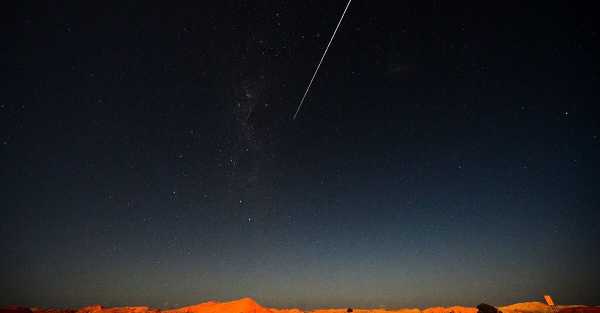
The chances of an asteroid hitting the Earth in 2032 have risen slightly and, while it is unlikely to happen, it is still very interesting to consider how we would respond to an event like this.
The asteroid, designated 2024 YR4, once had a 1.3 per cent chance of hitting the Earth, but this has now risen to 2.2 per cent.
Speaking to BreakingNews, head of research at MTU and Blackrock Castle Dr Niall Smith explained what would happen if this asteroid did crash into us.
The object is thought to be between 40 and 90 metres across, and Smith explained that its impact if it collided with Earth would depend on where it hit.
“If it did hit then it would depend a lot on where it hit. So this particular object we think is somewhere between 40 to 90 metres across. So when something like that happens you look for something where you have something comparable.
“And the closest comparable we have was in 2013 in Russia, in Chelyabinsk. There was an asteroid that was roughly 20 metres across and because it happened over this city, it did damage windows in about 7,000 buildings.
“I know there were about 1,000 people were given treatment for mostly flying glass. That was the biggest issue there, some ear drums burst and so forth because what you get is a pressure wave from an object this size.
“So when it comes into the atmosphere it gets super heated and that heat causes what we call an air burst. It mostly burns up in the air rather than hitting the ground and causing a big crater.
“It’ll probably break up a bit as it’s coming down, but it’s mostly this air blast. Now the thing about this air blast is it’s very hot and also the winds, if we think about Storm Éowyn, the winds from the air blast, they only last a second or two, but it’s maybe 1,000 kilometres an hour or something like that. So of course that can blow stuff out of the way and blow stuff down.”
Smith explained that if the asteroid happened to come down over Cork for example, that there would undoubtedly be damage caused.
“It would cause damage. There’s no doubt about it. It would be of the order of 500 nuclear bombs, but there would be no radiation.
“With an asteroid it is literally just a big lump of rock, no different from a bit of rock you would pick up outside. It’s effectively the same stuff.
“So, all that happens, not good admittedly, is it causes this big shock wave, all this heat. But once it’s gone, it’s gone. There’d be damage left behind but no radiation left behind.
“But anything that has the energy of 500 atomic bombs, if it did land over a city, you’d want to take it seriously.
“The chances though, from a science perspective, of it hitting the earth are slim. The chances of it hitting anywhere populated on the earth, like a city, are really really really slim. Most of us live in cities but cities actually only cover a tiny fraction of the surface area of the earth.”
Smith explained that, if the asteroid did collide with Earth, it would be “much more likely to land in the ocean”.
“We’ve seen some comments about tsunamis in the media. Really this is not the type of object to realistically cause a tsunami. It’s simply too small.
“It’s most likely that it’ll miss the earth and it’s most likely that if it did hit the earth, that it wouldn’t cause significant amount of damage. It’s really too small.”
‘It should still be taken seriously’
The asteroid should still be taken seriously, Smith said, and he explained that it is being continuously monitored.
“It is nevertheless being taken seriously. It’s not like: ‘Ah sure it’s fine’. There are a number of organisations closely monitoring this,” he said.
“There are two in particular. One is called the International Asteroid Warning Network and essentially that’s a network of telescopes that report on potential asteroids or other objects that might be going to collide with the Earth. So they monitor this.
“Then there is a second group, which is in Geneva, called the Space Mission Planning Advisory Group. They will meet in a couple of weeks’ time to reassess what we know about this object and whether or not we should start to think about ways that we could mitigate any impact from it.
“So what would be considered now would be, as we come to know more about its orbit and it looked bad for us, then they would start conversations about how we might do something.
“The obvious one is to send a spacecraft up to it, which impacts it, it’s called an impactor event, and you move it out of the way slightly so that it misses the earth. That technology exists.
“We’ve already done that with another asteroid. It wasn’t coming towards the earth but in 2022 NASA sent a spacecraft to an asteroid to test this idea out and it pushed this asteroid a little bit out of the way. It was successful, it was more successful than we thought. The asteroid moved more than we thought.
“So, in principle and in practice we have technologies that would allow us to move this out of the way. We have the technology to monitor these objects closer and now we have the technology to move objects of this size like this.
“If this was an object that was 10km across – now we’re in trouble. A little spacecraft bumping into the side of something 10km across is going to do very little. But those only happen every few million years.
“I think that it’s interesting because collectively as a species we can work together to protect ourselves from things like this if needs be. I think personally that’s interesting.”
Elon Musk to the rescue?
Smith said that, should an asteroid be on course to collide with the Earth, we may be forced to rely on some of the world’s richest and most powerful people to help us out.
“The best people on the planet for building big spacecraft quickly that work really well is SpaceX, owned by Elon Musk,” he said.
“The likes of NASA and the European Space Agency – they’re not built to make spacecraft quickly. It’s a whole other rationale. They’re not commercial so they don’t have to return a profit. They have a whole different business model.
“Whereas the one company that does this really well is SpaceX. You also now have Jeff Bezos from Amazon with his Blue Origin company.
“They are now also are building, and they were testing recently, the Glenn Rocket. It’s a big rocket. In principle at least both of those would be well placed to build a rocket in a short period of time.
“You could imagine them basically saying: ‘Give us a certain amount of money and of course we can build this for you and save the Earth’.”
Sourse: breakingnews.ie






